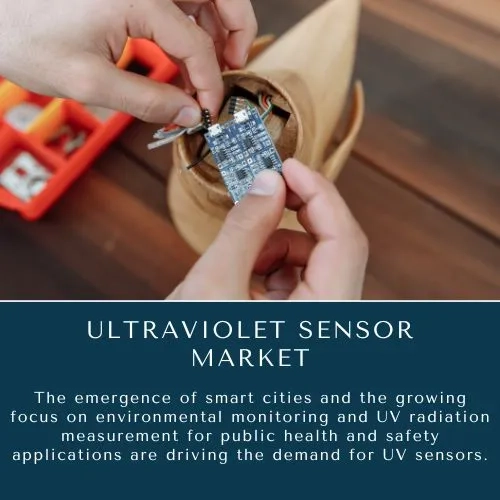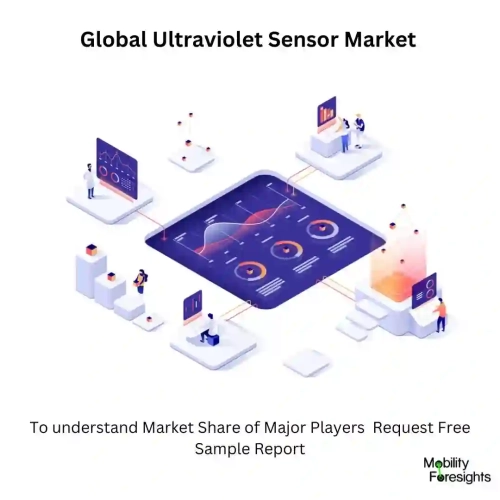
- Get in Touch with Us

Last Updated: Apr 25, 2025 | Study Period: 2024-2030
The global ultraviolet (UV) sensor market is witnessing significant growth due to the rising awareness about the harmful effects of UV radiation on human health and the environment. UV sensors play a crucial role in monitoring UV radiation levels in various applications, including sun exposure tracking, UV sterilization, water purification, and industrial processes.
With the increasing adoption of UV sensors in wearable devices, smartphones, smartwatches, and IoT-enabled devices, there is a growing demand for compact, accurate, and cost-effective UV sensor solutions. Furthermore, stringent government regulations and standards regarding UV radiation exposure, coupled with the rising concerns about skin cancer and other UV-related health issues, are driving the integration of UV sensors in consumer electronics, healthcare, automotive, aerospace, and other sectors.

Moreover, technological advancements such as the development of advanced UV sensor materials, miniaturization of sensors, and improvements in sensor accuracy and sensitivity are fueling market growth. The emergence of smart UV sensors with wireless connectivity and real-time data monitoring capabilities is further driving market expansion.
Additionally, the growing trend of smart homes and smart cities, along with the increasing demand for UV sensors in UV curing applications in the semiconductor and electronics industries, is expected to create lucrative opportunities for market players. However, factors such as high initial costs, limited awareness about UV sensor benefits, and challenges related to sensor calibration and accuracy may hinder market growth to some extent.
Nonetheless, ongoing research and development efforts aimed at enhancing sensor performance and expanding application areas are expected to drive the global UV sensor market forward in the coming years.
The global ultraviolet (UV) sensor market is experiencing rapid growth and evolution driven by the increasing awareness about the harmful effects of UV radiation on human health and the environment. Ultraviolet sensors play a crucial role in monitoring UV radiation levels, providing valuable data for a wide range of applications including sun protection, healthcare, environmental monitoring, and industrial safety.
With the growing prevalence of skin cancer and other UV-related health concerns, there is a rising demand for UV sensors in wearable devices, smart clothing, and personal UV monitors to help individuals track their exposure to UV radiation and take proactive measures to protect themselves.
Moreover, stringent regulations and standards implemented by governments and environmental agencies to mitigate the adverse effects of UV radiation are further fueling the growth of the global UV sensor market. These regulations drive the adoption of UV sensors in various sectors such as healthcare, aerospace, automotive, and agriculture to ensure compliance with safety guidelines and regulations.
Additionally, advancements in sensor technologies, such as the development of miniature, low-power UV sensors with high accuracy and sensitivity, are expanding the potential applications of UV sensors across diverse industries, driving market growth and innovation.

The Global ultraviolet sensor market is estimated to be worth $ XX billion by 2030, and is expected to grow at a compound annual growth rate (CAGR) of YY%. Another report projects that the market will reach $XX billion by 2030, growing at a CAGR of YY% from 2024 to 2030.
In the global ultraviolet (UV) sensor market, several trends are shaping the industry landscape. One prominent trend is the increasing demand for UV sensors in various applications, driven by growing concerns about skin cancer and the harmful effects of UV radiation on human health. As awareness about the importance of sun protection rises, the demand for UV sensors embedded in wearable devices, such as smartwatches and fitness trackers, is also on the rise.
These sensors provide real-time monitoring of UV exposure levels, allowing users to take proactive measures to protect their skin from overexposure to sunlight. Additionally, UV sensors are finding applications in industries such as automotive, aerospace, and agriculture, where they are used for monitoring UV levels to ensure product quality, enhance safety measures, and optimize agricultural practices.
Another trend in the global UV sensor market is the development of advanced UV sensor technologies to meet the evolving needs of end-users. Manufacturers are focusing on improving sensor accuracy, sensitivity, and reliability, as well as reducing power consumption and enhancing integration capabilities. Miniaturization of UV sensors is also a key trend, enabling their integration into compact electronic devices and IoT-enabled systems.
Furthermore, advancements in material science and semiconductor technology are driving the development of UV sensors with enhanced performance characteristics, such as wider spectral range coverage and resistance to environmental factors. These technological innovations are expected to drive further growth and expansion of the global UV sensor market in the coming years.
In the rapidly evolving landscape of the global ultraviolet (UV) sensor market, recent advancements have led to the development of innovative products with enhanced capabilities and applications. One notable development is the emergence of UV sensors with integrated artificial intelligence (AI) and machine learning (ML) algorithms.
These advanced sensors leverage AI and ML techniques to analyze UV radiation patterns in real-time, enabling more accurate and precise measurement of UV exposure levels. Additionally, AI-powered UV sensors can intelligently adapt to changing environmental conditions and user behaviors, providing personalized insights and recommendations for sun protection and UV risk management.
By combining cutting-edge sensor technology with AI-driven analytics, these next-generation UV sensors offer improved accuracy, reliability, and functionality, catering to diverse applications in industries such as healthcare, consumer electronics, automotive, and environmental monitoring.

Furthermore, another significant innovation in the global UV sensor market is the development of wearable UV sensors with biometric capabilities. These wearable devices integrate UV sensor technology with biometric sensors such as heart rate monitors, skin temperature sensors, and sweat sensors to provide comprehensive health and wellness monitoring.
By continuously tracking UV exposure levels alongside physiological parameters, wearable UV sensors can provide valuable insights into sun safety, skin health, and UV-related health risks. Moreover, these wearable devices can sync with mobile apps and cloud platforms to deliver personalized recommendations, UV exposure history tracking, and UV index forecasts, empowering users to make informed decisions about sun protection and outdoor activities.
With the rise of wearable technology and the growing emphasis on health and wellness, wearable UV sensors with biometric capabilities represent a promising new frontier in the global UV sensor market, offering innovative solutions for personal UV monitoring and sun safety management.
Market Segmentation of the Global Ultraviolet Sensor Market:
By Application:
By End-Use Industry:
By Type:
By Technology:
By Geographic Segmentation:
| Sl no | Topic |
| 1 | Market Segmentation |
| 2 | Scope of the report |
| 3 | Research Methodology |
| 4 | Executive Summary |
| 5 | Introduction |
| 6 | 5 Key Predictions for Global ultraviolet sensor Market |
| 7 | Insights from Industry stakeholders |
| 8 | Cost breakdown of Product by sub-components and average profit margin |
| 9 | Average B-2-B selling price in past 5 years |
| 10 | New product development in past 12 months |
| 11 | Expansion and Applications of the Global ultraviolet sensor |
| 12 | Importance of Technological innovation |
| 13 | Impact Thermal Storage Systems and Smart Grid Integration |
| 14 | Market Size, Dynamics and Forecast by Application , 2024-2030 |
| 15 | Market Size, Dynamics and Forecast by End-use industry, 2024-2030 |
| 16 | Market Size, Dynamics and Forecast by Type, 2024-2030 |
| 17 | Market Size, Dynamics and Forecast by Geography, 2024-2030 |
| 18 | Market Size, Dynamics and Forecast by Technology, 2024-2030 |
| 19 | Competitive Landscape |
| 20 | Gross margin and average profitability of suppliers |
| 21 | M&A in past 12 months |
| 22 | Growth strategy of leading players |
| 23 | Market share of vendors, |
| 24 | Company Profiles |
| 25 | Unmet needs and opportunity for new suppliers |
| 26 | Conclusion |